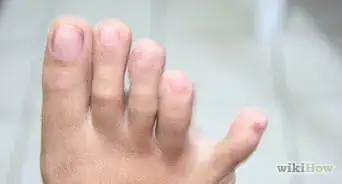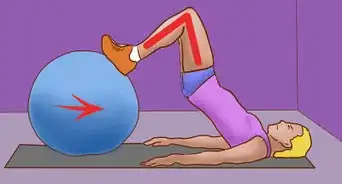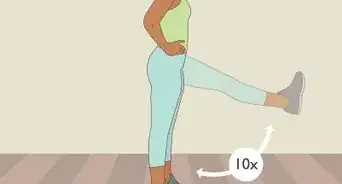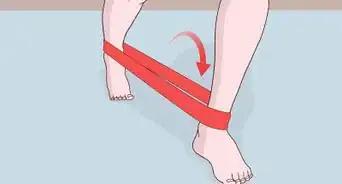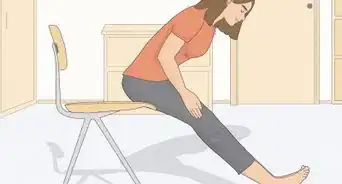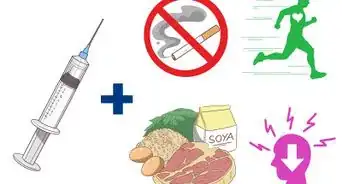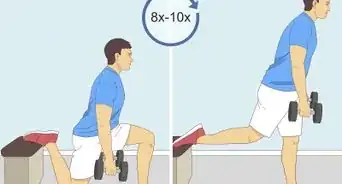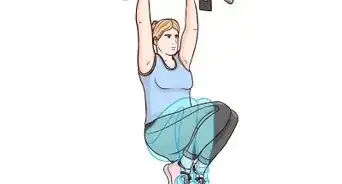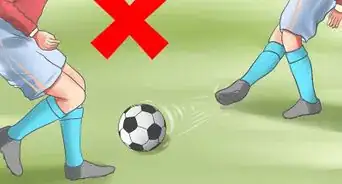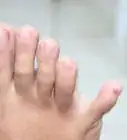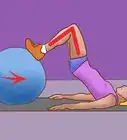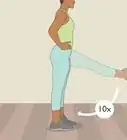This article was co-authored by Julian Arana, M.S.eD., NCSF-CPT. Julian Arana is a Personal Trainer and the Founder of B-Fit Training Studios, a personal training and wellness set of studios based in Miami, Florida. Julian has over 12 years of personal training and coaching experience. He is a certified personal trainer (CPT) by the National Council on Strength and Fitness (NCSF). He has a BS in Exercise Physiology from Florida International University and an MS in Exercise Physiology specializing in strength and conditioning from the University of Miami.
There are 12 references cited in this article, which can be found at the bottom of the page.
This article has been viewed 180,166 times.
Many people focus mainly on training and developing their upper body. They want broad shoulders, strong pecs, and a six pack so that they appear masculine and strong. The problem with focusing solely on the upper body is that your legs may begin to look small and scrawny in comparison. Don’t skip your leg workout. Instead, incorporate leg strength training into your workout routine and you will have big, masculine legs in no time.
Steps
Strengthening Your Leg Muscles
-
1Try squats. Squats are an excellent way to strengthen your quad muscles. Place your feet shoulder-width apart and then lower your pelvis so that your knees are bent. For proper technique your knees should never go past your toes while you are squatting.[1]
- You can squat using just your body weight or add additional weights.
- You can hold free weights in either hand at your side, or use a barbell with extra weight added.
- If you are using a barbell, hold the bar across your shoulders and keep your back straight.
-
2Include lunges. Lunges are great for working all of your leg muscles at once. Try to include lunges in your strength training routine at least once per week. To do a lunge, stand up straight and then step forward with one foot. Lower your body down towards the ground by bending your knees, hold for a few seconds, and then step back into the starting position.[2]
- Your back knee should drop down towards the ground while your front knee should bend until it is almost a 90 degree angle.
- Keep your front knee aligned above your ankle as you drop down.
- Do an equal number of repetitions on both legs.
- If you want to increase the resistance of this exercise, then you can hold a dumbbell in each hand. You can also hold a barbell and rest it across the backs of your shoulders for even more of a challenge.
Advertisement -
3Do deadlifts. Deadlifts are one of the best ways to strengthen your hamstrings (back of your thigh) and glutes (butt muscles). To perform a deadlift, stand with your feet shoulder-width apart and hold a barbell with your desired weight in front of you with your arms at your side.[3]
- Then, hinge forward from your hips while keeping your abs tight, and slowly lower your arms so that the bar is midway down your calf. While you lower the bar make sure that your back remains straight.
- Once the bar reaches the mid-calf range pull the bar back up to the rest position using your hips and legs.
-
4Include calf raises in your workout. Stand on a slightly raised surface, such as a step or ledge. Place the balls of your feet on the ledge and let your heels hang off the back. Then, lift your body up onto your toes and hold this position for two to three seconds. Next, lower yourself back down slowly taking another two to three seconds.[4]
- This exercise will strengthen your calves and will lead to muscle growth.
- You can perform calf raises using just your body weight, or you can hold free weights for a more intense workout or double the resistance by doing single leg calf raises (standing on one foot instead of both feet) for an even more intense workout.
-
5Strengthen your stabilizer muscles using exercise bands. The adductors (inner thigh) and abductors (outer thigh) are stabilizer muscles in the hips. When strengthened they can prevent injury and help with movement in the hips and pelvis. To strengthen these muscles, place exercise bands around your ankles, or below or above your knees.
- Then, try lifting one leg to the side while the other one remains planted. Repeat with both legs.
- Alternatively, you could bend your legs slightly into a squat position and then take small side-steps in one direction. Repeat the exercise while moving in the opposite direction.
-
6Do Swiss ball squeezes to work the inner thighs. An easy way to work your inner thighs is to squeeze a Swiss ball between your knees. You can do this while sitting, laying on your back, or even in the bridge position.
- Place the ball between your knees and squeeze your thighs inward to compress the ball. Hold the squeeze for a few seconds, and then release, rest for a few seconds, and repeat as many times as you like.[5]
-
7Use isolation movements to add tone. Most of your leg training should rely on free-weights, but you can use the leg curl and leg extension machines to help tone your leg muscles. Do not use too much weight because this could cause muscular imbalance or even patellar tendonitis. Instead, use a low to moderate resistance with high repetition. This will help to give your hamstrings and quads nice definition.[6]
Training to Build Muscle
-
1Work out your leg muscles three times per week. The frequency of training also contributes to muscle growth and development. If you want to get big legs, then you need to work out your leg muscles at least three times per week.[7]
- Do not complete leg exercises daily because this could lead to overexertion and injury.
- Always leave at least one rest day between leg workouts.
-
2Pair weight training with cardio. Although cardiovascular activities, such as running, swimming, jump rope, and cycling will help to develop aerobic leg muscles, these will often appear lean. If you want to get the look of big bulging leg muscles, then you will also need to include weight lifting exercises.
- You can start with your cardio workout, and then begin strength training, or vice versa.
-
3Train with heavy weights for fewer reps. Try lifting 80% or more of your one rep max (the maximum amount of weight you can lift) for each exercise you complete. Then, keep repeating the exercise past the burn phase and until you cannot complete a repetition. This is called working to failure and it will help you to build muscle.[8]
-
4Try single leg exercises to create balance. Chances are you probably have one leg that is more dominant and stronger than the other. This not only impacts the appearance of your legs, but it can also increase your risk of injury. To make sure that you develop muscles that are equal in size on both legs, you should try modifying your workout to include single leg activities. Some exercises that you can do on one leg include:[9]
- Calf raises
- Lunges
- Squats
Stretching and Recovering
-
1Stretch your legs before and after a workout. To prevent injury, you should always spend ten to fifteen minutes warming up your muscles by stretching. Do active or dynamic stretches before your workout to get your muscles moving. Some stretches to try include, straight kicks, hamstring stretches, inch-worm push-ups, and side shuffles.[10]
- Following your workout you should also stretch out your legs to reduce muscle tightness.
-
2Give your muscles time to rest. When you are training to build your leg muscles, it is very important that you give your legs a chance to recover and rebuild.[11] Always leave a rest day between each leg workout day. If you still want to hit the gym, that is fine, but focus on a different muscle group, such as your back, arms, or abs.[12]
- Be sure to have at least two complete rest days each week with no weight training.
-
3Foam roll your leg muscles. If your leg muscles get tight, you can use a foam roller after your workout to help loosen your muscles and decrease muscle soreness.[13] Roll the foam over tight muscles for approximately 20 to 30 seconds.[14]
Fueling Your Body
-
1Eat good quality protein before and after a workout. Even if you have the best leg workout routine, you will not notice the results without eating a well-balanced diet. Protein helps to rebuild muscles. When you are trying to build muscle, you should be eating 1.2 to 1.7 grams (0.04 to 0.06 oz) of protein per kilogram of your body weight. This is equivalent to about 0.6 to 0.85 grams (0.02 to 0.03 oz) of protein per pound of your body weight.[15]
- Some good sources of protein include chicken, lean beef, pork, milk, or cottage cheese.
-
2Consume a high calorie diet. When you are trying to build muscle, you need to eat a diet that is low in sugar, and that includes a balanced fat, protein, and carb intake. This will help you gain weight, and if you are eating healthy foods plus working out, the weight gain will likely come in the form of muscle growth.[16]
- It is important that your calories come from healthy proteins, fibers, and complex carbohydrates. Avoid eating unhealthy foods such as fried food, refined sugars, and saturated fats.
-
3Drink lots of water. Dehydration will make your workout extremely difficult and may cause your muscles to tighten and cramp up. A lack of water can also cause your muscles to weaken and lose some of their endurance. To build and sustain strong muscles, you should drink approximately one liter of water for every 1,000 calories expended each day.[17]
Expert Q&A
-
QuestionWhat should I do to recover after lifting on leg day?
 Julian Arana, M.S.eD., NCSF-CPTJulian Arana is a Personal Trainer and the Founder of B-Fit Training Studios, a personal training and wellness set of studios based in Miami, Florida. Julian has over 12 years of personal training and coaching experience. He is a certified personal trainer (CPT) by the National Council on Strength and Fitness (NCSF). He has a BS in Exercise Physiology from Florida International University and an MS in Exercise Physiology specializing in strength and conditioning from the University of Miami.
Julian Arana, M.S.eD., NCSF-CPTJulian Arana is a Personal Trainer and the Founder of B-Fit Training Studios, a personal training and wellness set of studios based in Miami, Florida. Julian has over 12 years of personal training and coaching experience. He is a certified personal trainer (CPT) by the National Council on Strength and Fitness (NCSF). He has a BS in Exercise Physiology from Florida International University and an MS in Exercise Physiology specializing in strength and conditioning from the University of Miami.
Certified Personal Trainer Recovery days are important for making progress in fitness and your recovery should vary depending on your training regimen. After lifting on leg day, you can incorporate foam rolling, stretching, and light cardio. You can even get the occasional massage to mix things up!
Recovery days are important for making progress in fitness and your recovery should vary depending on your training regimen. After lifting on leg day, you can incorporate foam rolling, stretching, and light cardio. You can even get the occasional massage to mix things up! -
QuestionWhat foods make your thighs bigger?
 Michele DolanMichele Dolan is a BCRPA certified Personal Trainer in British Columbia. She has been a personal trainer and fitness instructor since 2002.
Michele DolanMichele Dolan is a BCRPA certified Personal Trainer in British Columbia. She has been a personal trainer and fitness instructor since 2002.
Certified Fitness Trainer There is no food that specifically builds bigger thighs. You have to work the muscles with exercise and eat a healthy diet with at least 20-30% protein.
There is no food that specifically builds bigger thighs. You have to work the muscles with exercise and eat a healthy diet with at least 20-30% protein. -
QuestionHow do I get my legs bigger?
 Michele DolanMichele Dolan is a BCRPA certified Personal Trainer in British Columbia. She has been a personal trainer and fitness instructor since 2002.
Michele DolanMichele Dolan is a BCRPA certified Personal Trainer in British Columbia. She has been a personal trainer and fitness instructor since 2002.
Certified Fitness Trainer Try performing squats, deadlifts, jumping lunges and jumping jacks to make your legs bigger.
Try performing squats, deadlifts, jumping lunges and jumping jacks to make your legs bigger.
Warnings
- If you are working with heavy weights, always make sure to have a spotter with you.⧼thumbs_response⧽
References
- ↑ Julian Arana, M.S.eD., NCSF-CPT. Certified Personal Trainer. Expert Interview. 19 March 2020.
- ↑ http://www.shape.com/fitness/workouts/know-your-basics-how-do-lunge
- ↑ http://www.muscleandfitness.com/workouts/legs-exercises/5-keys-bigger-legs
- ↑ Julian Arana, M.S.eD., NCSF-CPT. Certified Personal Trainer. Expert Interview. 19 March 2020.
- ↑ https://www.exercise.com/exercises/inner-thigh-swiss-ball-squeeze
- ↑ http://www.muscleandfitness.com/workouts/legs-exercises/5-keys-bigger-legs
- ↑ https://www.bodybuilding.com/fun/28-laws-of-lifting-for-muscle.html
- ↑ https://www.muscleforlife.com/how-to-get-bigger-legs/
- ↑ http://www.mensfitness.com/training/pro-tips/how-get-stronger-bigger-calves
- ↑ http://www.muscleandfitness.com/workouts/legs-exercises/5-keys-bigger-legs
- ↑ Julian Arana, M.S.eD., NCSF-CPT. Certified Personal Trainer. Expert Interview. 19 March 2020.
- ↑ https://www.bodybuilding.com/content/recuperation-and-muscular-growth.html
- ↑ Julian Arana, M.S.eD., NCSF-CPT. Certified Personal Trainer. Expert Interview. 19 March 2020.
- ↑ http://www.mensfitness.com/training/build-muscle/10-foam-roller-moves-your-entire-body
- ↑ https://www.ncbi.nlm.nih.gov/pubmed/22150425
- ↑ https://www.bodybuilding.com/fun/wotw25.htm
- ↑ http://relentlessgains.com/why-water-is-important-to-build-muscle-and-how-much/
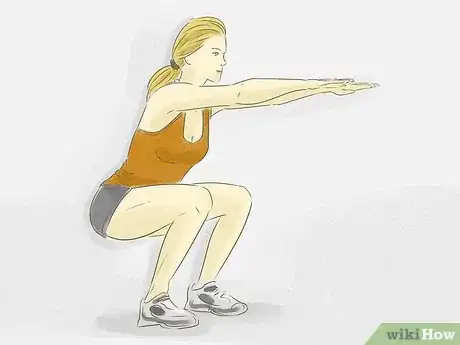

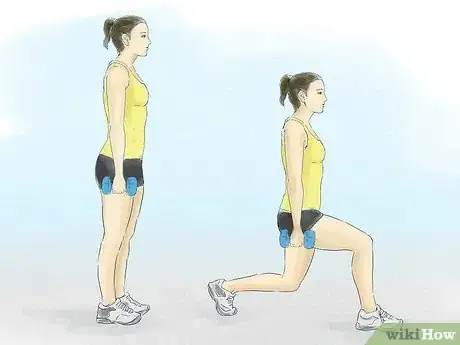
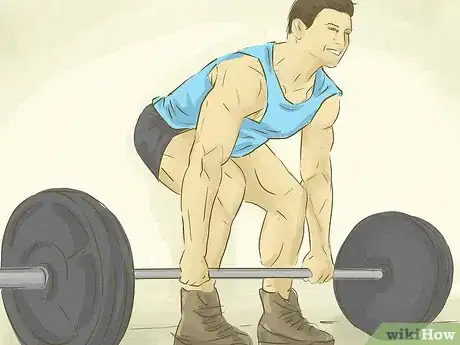
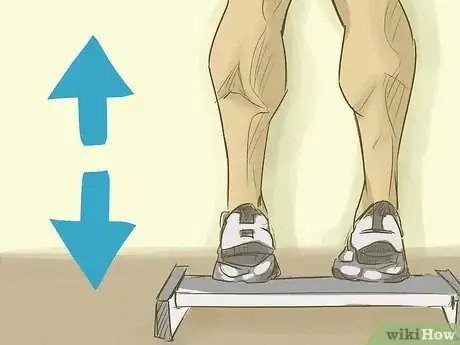
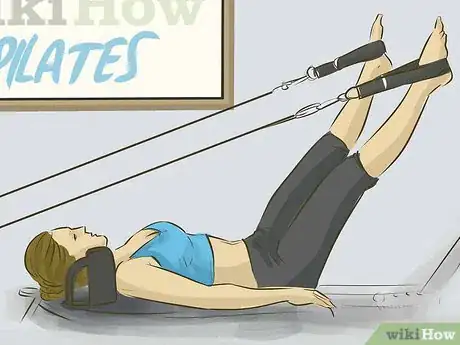
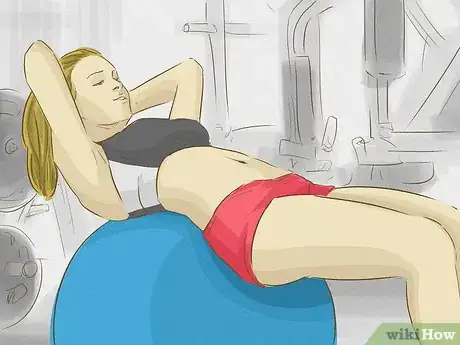

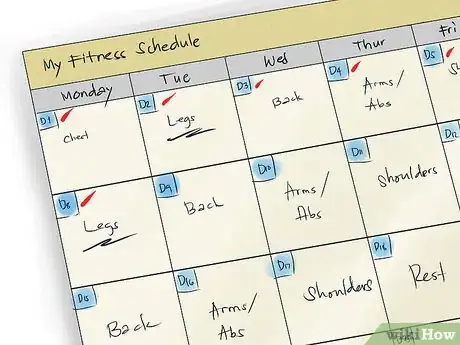
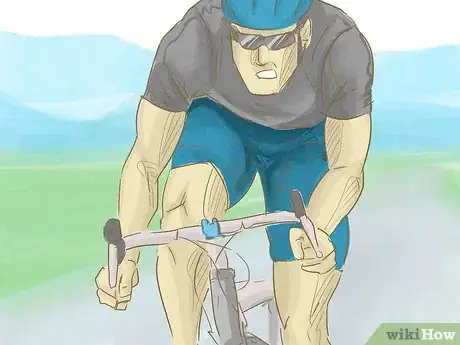
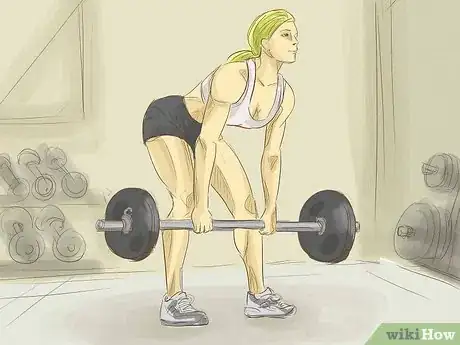
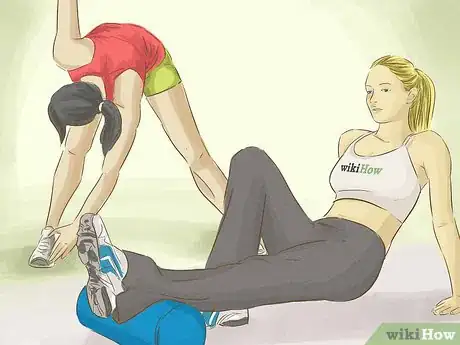
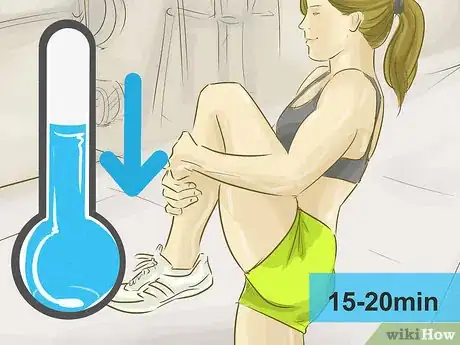

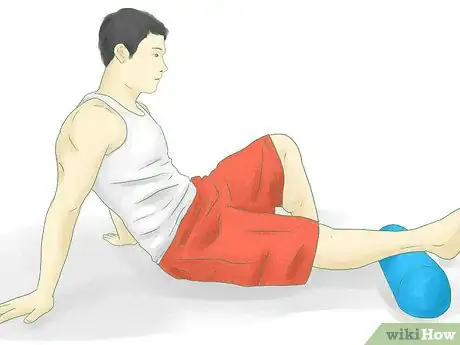
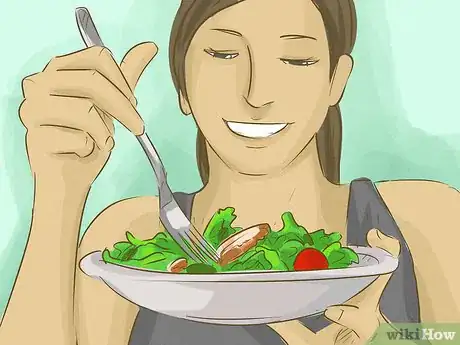
-Step-17.webp)
-Step-19.webp)
